We all have different ideas on what makes a favourite cache, for some, it is the type of cache, others it is the location, the hide, the adventure entailed in signing the logbook, the cache container or a combination of all.
On this page, we ask different cachers to list their noteworthy or all-time favourite caches along with the reason why. – To add your favourite send the Admin [@] 9ususalsuspects.uk (remove brackets)
A Favourite Cache
While traveling to Piratemania Germany we found just one brilliant cache in the Netherlands:
GC4Z1XM Stokrozen Cache by Onnorvid Traditional D1.5/T1.7
At the time of writing this cache has 741 well deserved favourite points which I’m sure will only increase.
Naturesbyte’s favourite Caches
No. 1 – St Melangell’s Church, (GC1C1GQ) Tonibunny – 28th May 2007
A favourite Geocache of mine is an ancient religious site in Llangynog, Powys, Wales. It has both history and a peaceful setting. To say that it is remote is an understatement, the church and a very few houses can only be reached down a long track off the B4391 or via a network of footpaths that span the Berwyn Mountains.
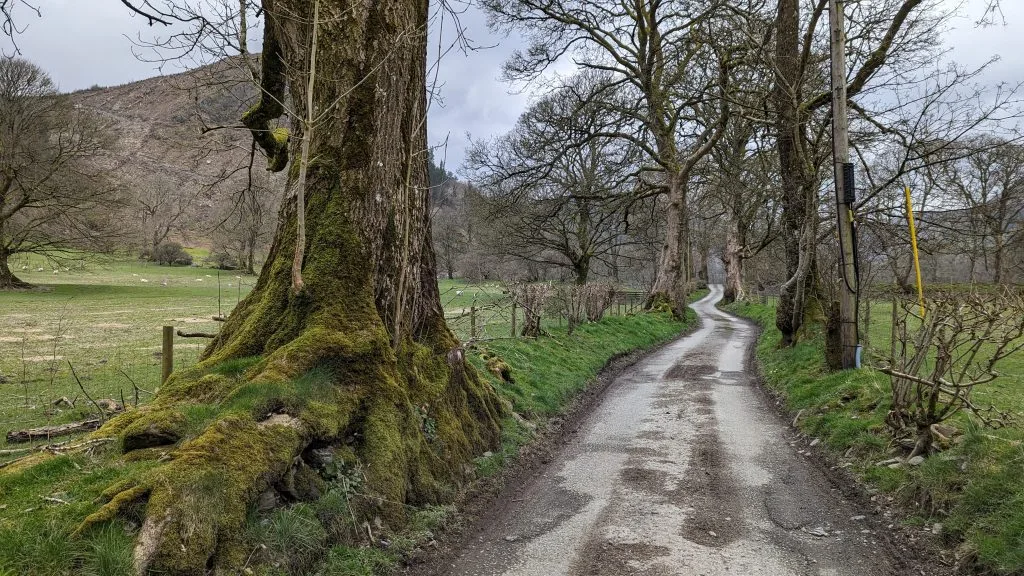
It’s one of those rare places that it has been in constant use thousands of years for worship of various deities from Bronze age to the Christian church which stands there now. As you look around the church yard there are four stately Yew trees that are at least two thousand years old predating the current structure.
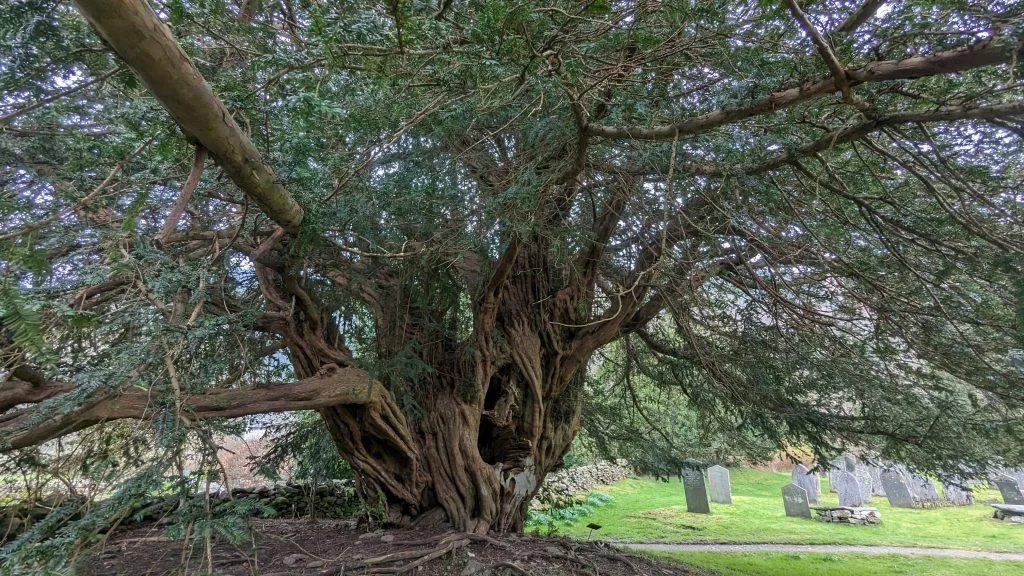
There are many gravestones the oldest dating from 1680 right up to the relatively recent burials. The age of the site was revealed when Mid-Bronze age burials were found in the churchyard on an archaeological dig to establish the age, it’s also thought that an older barrow may have existed on the site of the church itself.
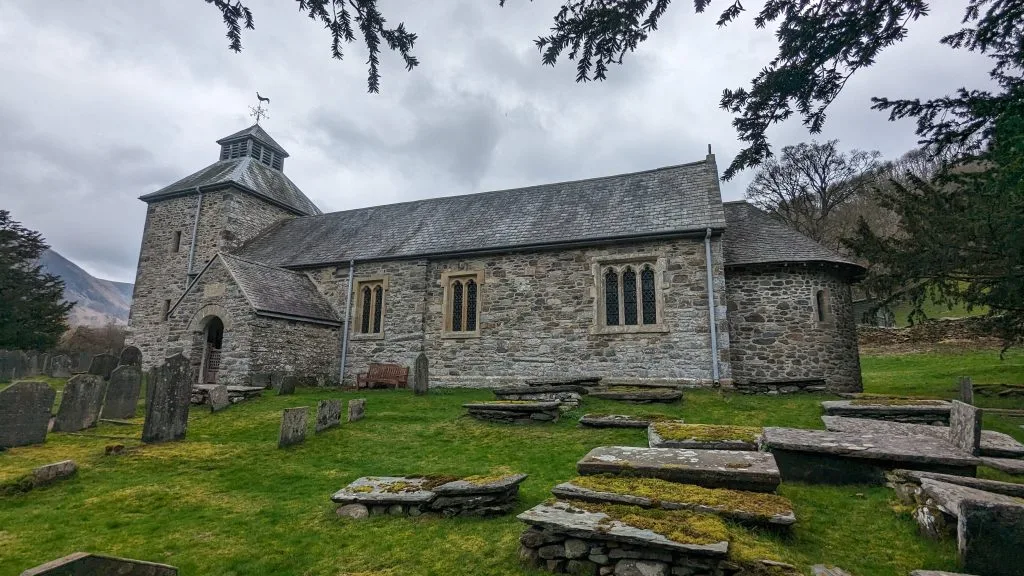
The interior of the church bears witnesses to changing patterns of Christian worship for nearly a thousand years, the origins of Christian worship on the site dates to around the seventh or eighth century when a community of nuns led by St. Melangell (Monacella) after who, the church is named founded a convent. The original convent was a wooden structure and was replaced by a stone building in the late twelfth century to match the needs of the worshipers and the lucrative pilgrim trade, St. Melangell’s shrine (the oldest surviving Romanesque shrine in Northern Europe) offered ‘miraculous cures’ for illness and other spiritual benefits for the pilgrim. That the shrine survives to this day is exceptional.

Most British shrines were destroyed either in the Reformation, or when major religious upheavals occurred, sometimes this was as drastic as sweeping away all previous iconography, as in the ‘English’ Civil war where so many churches across Britain were gutted and used as stables, barracks or warehousing. We perceive churches as austere colourless places which in the past was far from the truth, before the reformation in the mid sixteenth century churches were painted with brightly coloured interiors depicting religious scenes for the largely illiterate congregation, traces of these paintings can be seen at various places around the church. In the reformation ‘Superstitious images’ came under attack as Henry the Eighth sought to break with the Pope and Catholic church. Up and down England & Wales, pictures of saints, screens separating clergy and congregation, relics and miracle-working statues were ripped out of parish churches and destroyed, the remoteness of this church and the small insular Welsh speaking community probably saved the shrine from destruction, tragically not the wall paintings though.
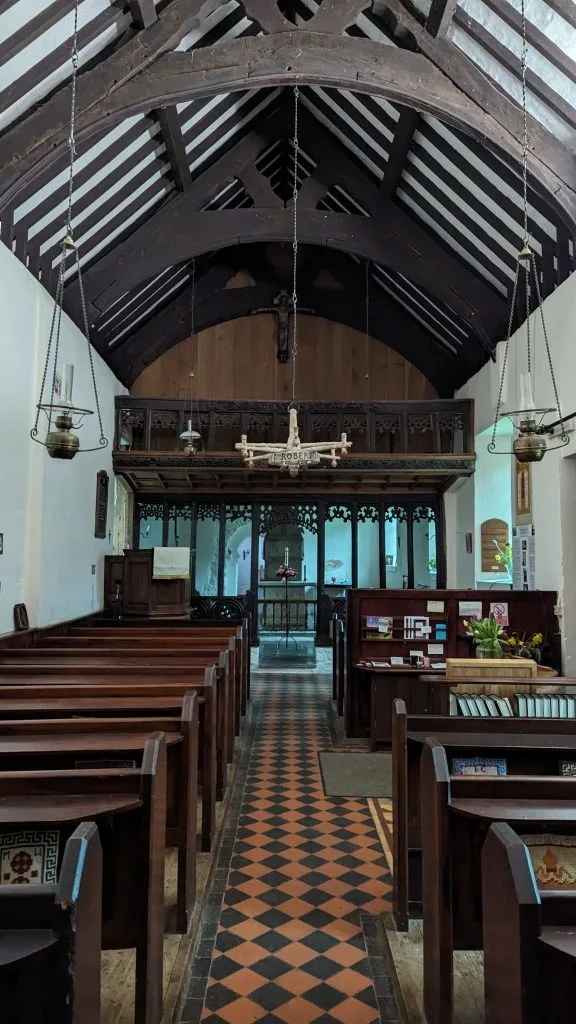
Over the centuries repairs have changed the church but, on the whole the fabric and feel remains the same.
April 2021 – To get us started here are some of Ann@Birdbrook’s favorite caches
GC4WEDK 147 Snooker Challenge D5/T4 Challenge Cache UK
I like a good challenge and this is certainly one. For this cache all you have to do is find 36 caches in a day, simple, well it’s not quite that easy. Basically, you are playing geocaching snooker, different types of cache count as the different coloured balls as in snooker and you have to score a maximum break of 147! See the cache page for the rules. The idea for this cache is “borrowed” from Just-Us-Two, the original cache being GC4NYHP.
Disappointedly we failed this challenge on our first attempt, too many DNF’s and too long spent looking for parking spots resulted in us running out of time. Having learnt from our mistakes we planned our next attempt like a military operation – even having a dry run to check parking spots. We had a great sense of achievement in signing the logbook of the well-hidden nano.
GC1TG4P Intertidal Footprints D5/T3.5 Earthcache UK
I am not a big fan of earthcaches but this one is very special. Coastal erosion at Formby has revealed the sub-fossil footprints of humans, animals and birds preserved in laminated silt exposures. Due to constant erosion and shifting sand, the coordinates are for the general area. We had tried twice looked unsuccessfully to find this earthcache so signed up for The National Trust Guided walk. Our guide was excellent, answered all our questions and took us to an area about 500m away from the published coordinates where we immediately found human footprints. At the first location, we found Human, Oyster Catcher and what was probably Aurochs footprints. The best discovery of the day was a trail of footprints left by an adult with a child’s set of prints running alongside. They looked so perfect that they could have been made that morning. At the second location a bit further south, we found Crane and Red Deer, here the laminated deposit was a completely different colour. The guided walk is highly recommended for this one, cost about £5.00 – worth every penny!
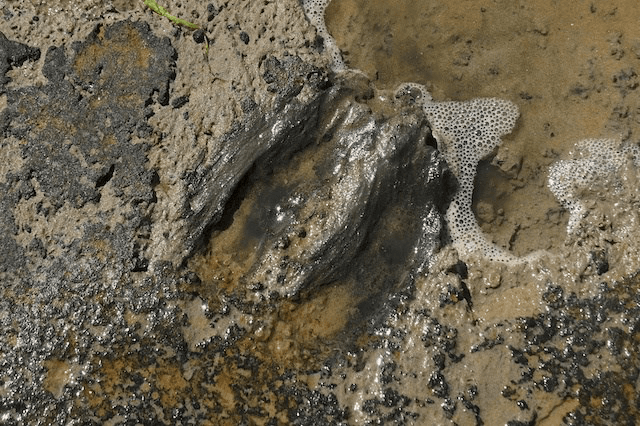
GCKCJV Ghost Village (Wiltshire) D5/T1.5 Virtual UK
This is one of those places I would never have known about, let alone visited if it had not been for geocaching. The virtual cache is found in Imber, Salisbury Plain, a village taken over by the army in 1943 as a training ground. Originally the residents were told that they would be allowed to return after the war but this was never permitted. As the village finds itself in the centre of a military range danger area it is only open to the public at certain times of the year and with very strict access rules. The whole experience is very surreal, the drive across Salisbury Plain with its abandoned tanks to the perfectly preserved church and graveyard.

GC6K8BF Ogof Clogwyn D5/T5 Letterbox UK
I have not found many letterbox caches mainly because there are very few in our local area. While planning a trip to find the oldest cache in Wales this letterbox caught my attention initially because of its type but also it being a D5/T5. I’m not that good with confined spaces but after studying the cache page and a bit of general research on the internet there didn’t appear to be any tight squeezes or anything too difficult. Ogof Clogwyn is rated as a beginners cave therefore it has plenty of space and head room. This cave really has the WOW factor. The walls are lined with amazing rock formed shelves, so, as with any cave/mine, hard hats are a must. I’m surprised there is not an Earthcache here. The hardest bit was getting into the cave as there was a lot of water tumbling out of the entrance which is quite high. Once in, armed with a laminated copy of the excellent instructions it was easy to find the route to the cache. To be honest it would be very hard to get lost. Be prepared to get wet! Oh and the water is very, very cold.
This is one of those caches that you wish you could give more than one favourite point too.
As the cache pages says ‘its simply a pretty cave in a pretty spot”.

GCM7R6 Northside Pub Crawl D2.5/T1.5 Virtual & GCJJVZ Southside Pub Crawl D3.5/T1 Virtual Ireland
If you are in Dublin and love pubs these two caches are a must. All answers to the clues are on the outside of the buildings but the inside of the pubs are worth a look and you really should sample the quality of their Guinness. These two caches are great to do in a group, we had a fantastic weekend of drinking and caching around the City, only realising a little too much Guinness had been consumed when it came to working out the final calculations! Also after visiting the 20th pub the terrain rating maybe a little on the light side……..

GC3D4F9 Arte de Portas Abertas D2.5/T1 Multi Portugal Madeira
I usually avoid Multi Caches especially if they have lots of stages, they always seem a lot of work for very little. This cache guides you through an area that is best described as an outdoor art gallery. A near derelict street of Funchal was brought back to life by The Art of Open Doors project. Local artists were commissioned, each artist being allocated a space/door to express themselves, with their imagination and a few low-cost resources, the street was transformed. As the tourists began to visit they were quickly followed by shops, cafes and bars. The area is now thriving with very little evidence of its past. The final cache is not great but the artwork makes up for this.

